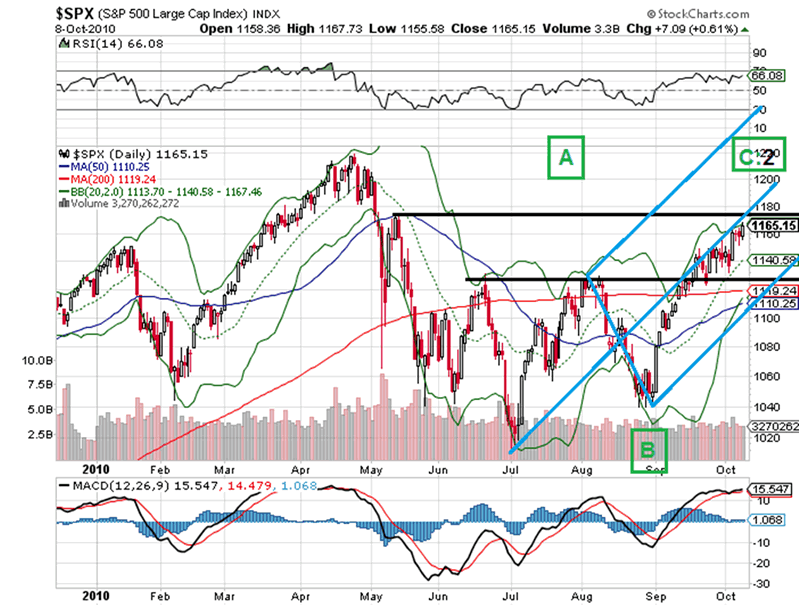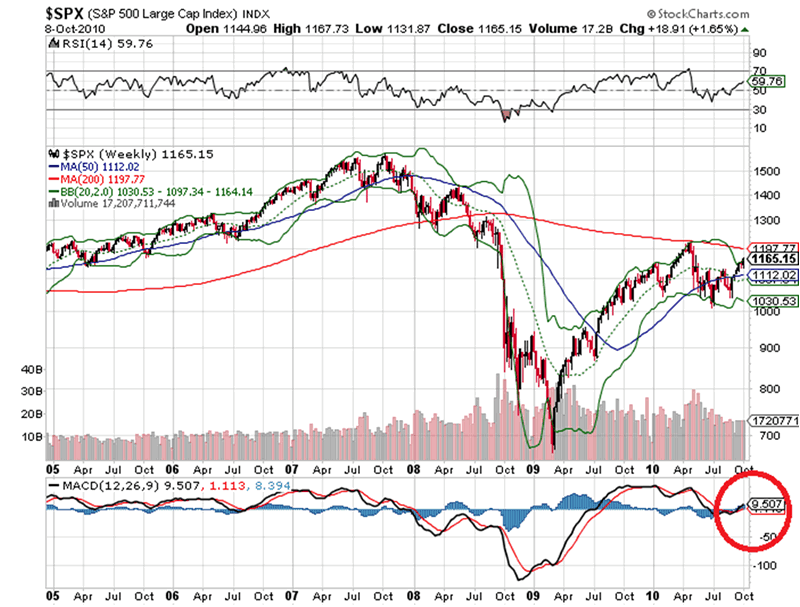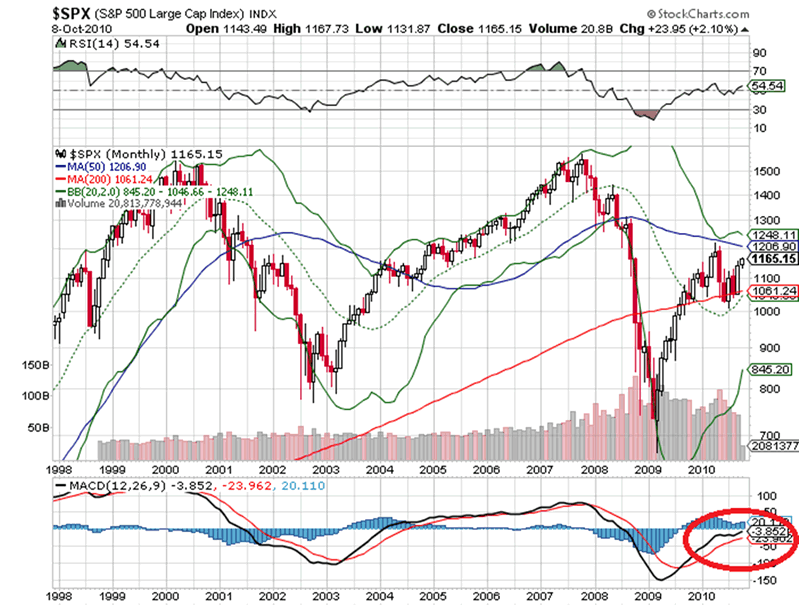Stock Market Elliott Wave Analysis, Wave 3 Down?, and Quantitative Easing
Stock-Markets / Stocks Bear Market Oct 11, 2010 - 11:14 AM GMTBy: JD_Rosendahl
 A Reader Asks All Word Questions at the Right Time
A Reader Asks All Word Questions at the Right Time
In the short time of running my own website I've received some great, interesting and well thought out questions, comments and data from readers. It's one of the things I truly enjoy, as it serves as a collective body of work from like minds with similar interests.
Recently, a reader emailed me the following:
Hi J.D.
I love your blog as always. Thank you for your unbiased look at things.
I know you do Elliott Wave analysis and I am an EWI subscriber. I am quite confused about the direction of things at this point. EWI says/has been saying since April that primary wave 3 is going to knock this market on its keister. I want to believe this but the fed/banksters keep getting in the way.
I want to believe that primary wave 3 down is imminent but QE2 is in direct conflict with it. There is confusion between the pumping of assets by the fed and pw3. Do you think asset prices just keep melting up from here or is wave two just about done doing its job of re-igniting optimism and flushing out the majority of bears before we fall again? Your thoughts would be much appreciated. Thank you.
My initial comment to the reader is WOW, what a great email. I'm assuming these comments and questions come from a person who has money at work or soon to be at work or maybe coming off the table.
First, thanks for the compliment. I'm glad my view on the world of investments and money helps. I get a thrill out of that. I learned a long time ago that bias can be very dangerous if not supported by either great fundamental data in a secular bull market or by solid technical analysis in a trading environment.
Otherwise bias is nothing more than how we feel, based on internal emotions like fear and greed, which almost always cause highly flawed investment decisions. Personally, this is why I exclusively use technical analysis for trading; it takes the emotion almost completely out of the equation.
Let's get to the meat of the readers email and one of my favorite topics: Elliott Wave Theory. First, I'm going to start with something I have to share with the public, which are my own Elliott Wave rules. I call them "Rosey's Rules."
Rule 1: I hardly ever, and I mean hardly ever, lead with EW or use EW analysis exclusively. While I firmly believe price is the most important technical data, by itself you'd be lucky to bat 500 with your trades. I personally use a Candlestick chart with Bollinger Bands and 2 indicators. I prefer the MACD and RSI only because it works for me. I've tried others, but the two I use work the best for me. My personal experience is a combination of these tools help clarify the Elliott Wave count and more importantly, increase my ability to get my trades correct. And that's all it should be about.
Rule 2: Sometimes the exception to Rule #1, for me, is wedge patterns. What can I say? It's a pattern I like.
Rule 3: Not every high or peak is part of an impulse move. It's not Elliott Wave Science and that easy. If there's one consistent failure I see in analysis, it's the lag time it takes to understand an irregular flat or running correction in play where a wave makes a new high; but it's really part of a corrective pattern. This kind of market price action happens more often than is discussed and gets missed until it's well past and obvious. Think of it as Mr. Market's way of confusing investors.
Rule 4: If you label the market with an Elliott Wave count based on the way it looks you might be wrong more than you're right. Again, it's not that easy.
Rule 5: Chances are when you think the wave count has finished, there's probably one or two more minor waves in the count before it's done. Anyone can count 5 waves up or an ABC but it's rarely that easy, otherwise everyone would use it and we'd call it Elliott Wave Science.
Rule 6: Know which waves and patterns you want to trade. You shouldn't try to trade every wave. Sometimes it makes sense to park it or go find something that is in a wave you want to trade. For this, I highly recommend the book: How to Identify High-Profit Elliott Wave Trades in Real Time, Myles Wilson Walker.
Rule 7: Always try to understand what the opposing wave count or pattern is so you know your risk, and use your technical indicators to gauge the probability of the various patterns.
Rule 8: Never assume the big name Elliott Wave analyst has it right just because he's a big name. They get it wrong just as much as anyone else. Sure, they know the theory and principals inside and out and talk circles around everyone, but they get it wrong more often than they admit. This is where your common sense and your own technical analysis need to come into play.
Rule 9: If an analyst is calling for a major top, I would expect to see some kind of topping pattern or bearish divergences in big name stocks like IBM, CAT, MMM, etc. and the big momentum tech. plays. Those are the stocks that drive the market and if the markets are going to sell off significantly, these stocks have to participate and therefore we should expect them to show those technical indications. It doesn't have to happen that way but that seems like common sense to me.
The above rules are something I personally developed when I was a subscriber to an Elliott Wave service for a few months in 2003 and they were consistently calling for an ending diagonal for a massive wave 3 down but it turned out to be a running correction as the market continued higher into 2007. During those few months I was losing money consistently using their analysis. I guess that was what I paid for education into Elliott Wave analysis. I hope the above rules help you think outside the box about using Elliott Wave theory whether it's yours or someone else's.
Don't get me wrong, I think Elliott Wave Theory is a highly valuable tool, but like everything else, it's just one of the tools in the box.
EWI (Elliott Wave International)
First, let me just say, "I agree with their premise that the end of the major cycles is near and deflation is here and will become the major theme of the next several years. I've been running a deflationary money strategy for my parents since 2003 and I know few people that have a better risk adjusted return or money model than we do. I look for it all the time but I rarely find anything I like.
We sold their home in 2003, which was 2 years before their top in 2005. We bought gold in 2003/4 and in 2008 their wealth went up because we were short in the market. I'll admit 2009 was not a banner year because we simply didn't feel the need to chase the market because we didn't have losses to make up. So from the concept of deflation and deflationary investing in general, I agree with most of what I've seen from EWI.
However, what I do not care for at all is what I call their purest model of presenting Elliott Wave counts. For the most part, they deal in price only without the use of Bollinger Band or 2 indicators. If all you use is price then you can get stuck in the trap of labeling every new high as the end of wave 2 up, over and over and over. Hence Rosey's Rule 1, 3, 4, 5, 7, 8, and 9 above. I personally do not care for the purest way of presenting Elliott Wave theory, but that's my trader's view.
Here's a thought for the back of your head: If one continually labels every new squiggle and wiggle higher as the end of wave 2 then one will eventually call the top into a massive wave 3 down. Something one can refer to later in life as the greatest investment call for marketing purposes, while not referring to how often they got it wrong. Most people will only remember the big call, and the psychological part of Elliott Wave Theory confirms that human behavior.
Wave 3 Down?
Let's back up and use a little common sense. First, there are a lot of market professionals that are just as confused as you and I are, so that's really not something to get stressed about. Mr. Market does this all the time by pushing the action in price and time into No Man's Land, vexing market participants.
Moreover, no one, and I mean no one, makes the Wave count. That's Mr. Market's job. All we can do is understand that the potential for a wave 3 down exists and what we should look for to confirm or deny that. Currently, I believe we have an ABC pattern wave up and a pull back is coming. And that view is currently unconfirmed because Mr. Market has pushed price into No Man's Land where neither bulls nor bears have confirmation of their view.
$SPX: If we look at the daily chart of the market below, I've drawn in price support and resistance. I'm using these two levels to confirm either view. Above 1,173-75 and it's highly likely wave two up is probably not wave 2 up and some other form of correction is more likely to play out if the market doesn't melt up. If we trade below 1,122-1,125 we have some over lapping and our first little confirmation wave 2 up is done. You're belief in wave 3 should only gain momentum when there is solid technical evidence wave 3 has started, period.

I try not to think in absolute terms when the market is in No Man's Land, that's just dangerous to my trading. I want to handicap what the major possibilities are and let Mr. Market show me the way. This is the way we have to think if we have money in, about to go into or coming out of the market. You can be stubborn in your view when you're not involved in the market.
Quantitative Easing and Markets Trading Higher:
Now we want to analyze if the Bobbleheads in Washington pull a rabbit out of their hat near term and QE2 works for a few months and supports the market moving higher. When I'm thinking about alternatives like this, I often think it backwards: If it's a few months down the road, and the market has made another high for this rally. If it happens, then today we should be able to find technical data that supports that possibility.
$SXP Weekly: The weekly chart below represents the potential bullish case. You'll notice the weekly MACD has crossed and is heading higher. Simply put, that's bullish. The markets will need to roll over soon and roll that weekly MACD over to change that.

$SPX Monthly: The monthly chart reflects the monthly MACD was moving sideways then started moving higher again. That's bullish too.

Rosey's Call: I've been calling for a top near term into the end of September 2010, which might be the first week of October or so. I'm not ready to commit to anything more than corrective behavior based on the daily chart. It's too early to pencil in a wave 3 down for the prudent trader. That's irresponsible. It could be or it could be just a pull back or the market could just keep going higher. I'm personally skeptical right now on a wave 3 down, but I'm always skeptical.
If it is wave 3 down, here's what I'm looking for. First, I want to see the market put in a series of impulse waves down, a series of small 1s and 2s. That would be a great start. The $VIX needs to rock higher out of a wedge pattern. The JNK needs to roll. IBM needs to fall back below $132 (support). And all the big tech momentum stocks (AAPL, AMZN, BIDU, GOOG, and PCLN) need to roll over because market participants should sell off risk in a wave 3 down. Those are my clues.
My personal alternative view is if the market is going to trade higher, then a natural place for a top is when both the weekly and monthly MACDs are above zero. That will take a few more months and I personally like the December 2010 to January 2011 time frame because that represents the 21 Fibonacci number on a monthly count from the March 2009 low, and my time frame represents the 21/22 month cycle.
That's my take on a very well thought out and timely email.
Hope all is well.
By J.D. Rosendahl
www.roseysoutlook.blogspot.com
J.D. Rosendahl was a former stock broker/investment consultant (currently not licensed) before becoming a Commercial Banker for the past 14 years. He manages his family's wealth, helping them avoid the high tech bubble and the real estate bubble melt downs and preserving wealth.
© 2010 Copyright J.D. Rosendahl - All Rights Reserved
Disclaimer: The above is a matter of opinion provided for general information purposes only and is not intended as investment advice. Information and analysis above are derived from sources and utilising methods believed to be reliable, but we cannot accept responsibility for any losses you may incur as a result of this analysis. Individuals should consult with their personal financial advisors.
© 2005-2022 http://www.MarketOracle.co.uk - The Market Oracle is a FREE Daily Financial Markets Analysis & Forecasting online publication.



